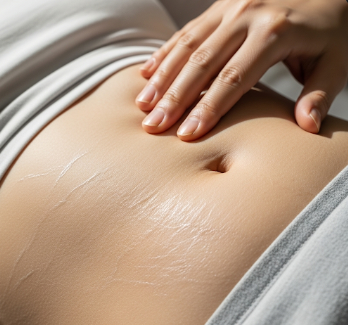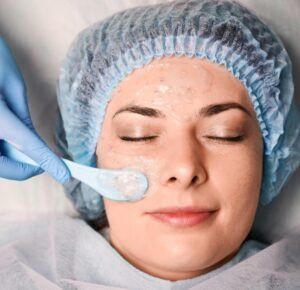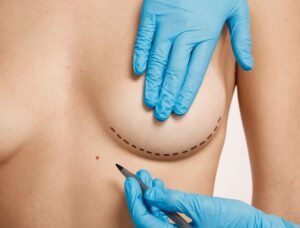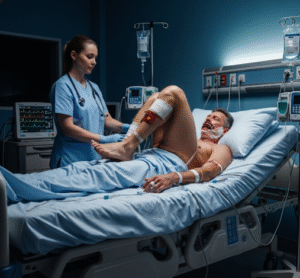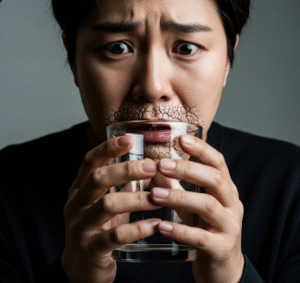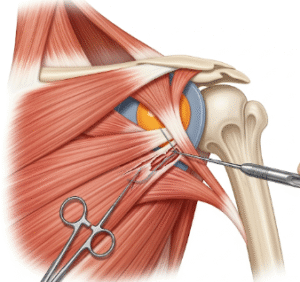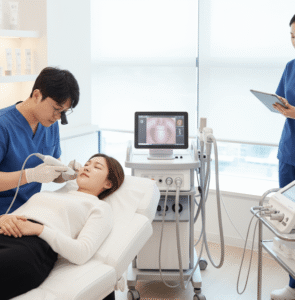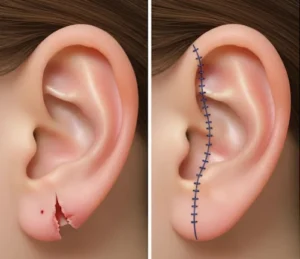➤ Overview
Stretch marks, medically known as striae, are a type of skin scarring that appears as streaks or lines on the skin. They commonly occur due to rapid stretching of the skin and are often associated with growth spurts, pregnancy, weight gain, or hormonal changes.
In South Korea, dermatologists and cosmetic specialists provide diagnosis, treatment, and preventive guidance for stretch marks. While generally harmless, stretch marks can cause emotional distress and affect self-confidence, making treatment and education important.
➤ Key Facts
→ Stretch marks affect both men and women, but are more common in women, particularly during pregnancy.
→ Common sites include the abdomen, thighs, hips, breasts, and upper arms.
→ In Korea, dermatologists assess stretch marks using clinical examination, dermoscopy, and imaging for treatment planning.
→ Stretch marks are often cosmetic concerns, but may sometimes indicate underlying hormonal imbalances.
→ Early intervention and proper skincare can reduce their appearance and improve skin elasticity.
→ Genetic predisposition plays a role—some individuals are more likely to develop stretch marks.
→ Treatments include topical creams, laser therapy, microneedling, and professional skincare routines.
➤ What is Stretch Marks?
Stretch marks are linear scars that develop in the dermis, the middle layer of the skin, due to rapid stretching or hormonal changes:
→ Striae rubra (red/purple) – Early-stage stretch marks that are more noticeable and may be treated effectively.
→ Striae alba (white/silver) – Older stretch marks that have faded and are more difficult to treat.
→ Physiological stretch marks – Occur naturally during pregnancy, puberty, or rapid growth.
→ Pathological stretch marks – Associated with conditions such as Cushing’s syndrome or long-term steroid use.
→ Localized stretch marks – Limited to specific areas due to localized skin stretching.
→ Generalized stretch marks – Extensive and associated with significant weight change or systemic causes.
Korean dermatologists classify stretch marks based on appearance, age, and underlying cause to select the most effective treatment.
➤ What Symptoms are Related to Stretch Marks?
Stretch marks are primarily cosmetic but may cause discomfort or emotional concern:
→ Linear streaks or lines on the skin surface.
→ Red, purple, or pink coloration in early stages.
→ White or silver lines in older stretch marks.
→ Mild itching or tightness in affected areas.
→ Texture changes – Skin may feel slightly raised or indented.
→ Psychological impact – Reduced confidence or self-consciousness about appearance.
→ No pain or systemic symptoms in most cases.
➤ What Causes / Possible Causes?
Stretch marks develop due to mechanical stretching of skin, hormonal changes, or genetic predisposition:
→ Pregnancy – Rapid expansion of the abdomen and hormonal changes.
→ Puberty – Growth spurts and hormonal fluctuations in adolescents.
→ Rapid weight gain or loss – Stretching or shrinking of skin tissues.
→ Bodybuilding or muscle growth – Sudden increase in muscle mass.
→ Hormonal imbalances – Cortisol excess from Cushing’s syndrome or steroid medications.
→ Genetic factors – Family history of stretch marks increases susceptibility.
→ Certain medical conditions – Ehlers-Danlos syndrome, Marfan syndrome, or prolonged corticosteroid use.
➤ When Should I See My Doctor?
Stretch marks are generally harmless, but medical consultation is recommended if:
→ Stretch marks appear suddenly and extensively without obvious cause.
→ They are associated with other symptoms of hormonal imbalance, such as rapid weight gain, fatigue, or facial changes.
→ Persistent itching, pain, or inflammation develops.
→ Concerns about cosmetic appearance and desire for treatment.
→ Underlying conditions such as Cushing’s syndrome or long-term steroid use are suspected.
➤ Care and Treatment
Treatment focuses on reducing appearance, improving skin elasticity, and preventing new marks:
→ Topical treatments – Creams with retinoids, hyaluronic acid, or vitamin E may improve early-stage stretch marks.
→ Moisturization – Regular use of emollients to maintain skin hydration.
→ Laser therapy – Fractional lasers and pulsed dye lasers can stimulate collagen and reduce discoloration.
→ Microneedling – Promotes collagen production and skin regeneration.
→ Chemical peels – Mild peels improve skin texture.
→ Healthy weight management – Prevents rapid stretching of skin.
→ Sun protection – Prevents further skin damage and discoloration.
→ Professional skincare advice – Tailored treatments based on age and severity of stretch marks.
➤ Treatment Options in Korea
South Korea offers advanced dermatologic and cosmetic care for stretch marks, combining medical treatments, technological procedures, and preventive guidance:
Diagnosis in Korea
→ Clinical examination by dermatologists – Assessing type, severity, and age of stretch marks.
→ Dermoscopy or imaging – For detailed evaluation of skin layers and planning treatment.
→ Assessment of underlying causes – Hormonal evaluation if systemic conditions are suspected.
Medical Treatments in Korea
→ Topical therapies – Prescription creams with retinoids or hyaluronic acid.
→ Laser therapy – Fractional CO₂, pulsed dye, or Nd:YAG lasers for pigmentation and texture improvement.
→ Microneedling or radiofrequency therapy – Enhances collagen formation and skin regeneration.
Advanced Therapies in Korea
→ Combination treatments – Laser, microneedling, and topical therapy for optimal results.
→ Professional skincare programs – Hospital or clinic-based regimens tailored to skin type and severity.
→ Integrative approaches – Korean traditional medicine techniques, including herbal therapy, to support skin health.
Rehabilitation & Support in Korea
→ Guidance on skin care routines, hydration, and sun protection.
→ Education on weight management and healthy lifestyle habits to prevent new stretch marks.
→ Follow-up care to monitor progress, prevent recurrence, and maintain skin elasticity.

